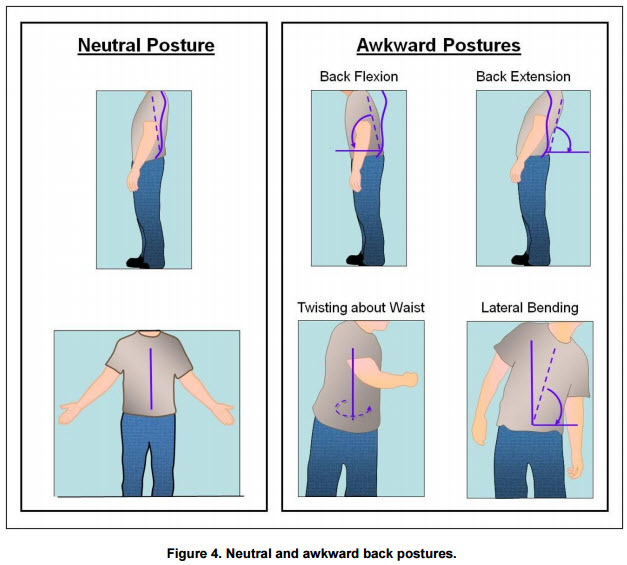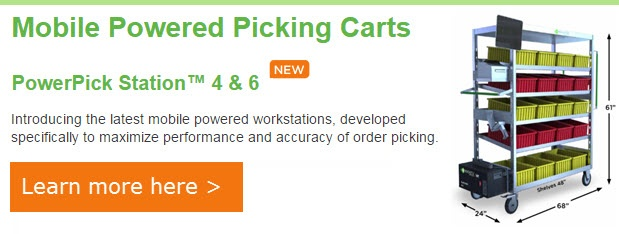
Improving the productivity and safety of your warehouse through ergonomics
While OSHA requires the training and means for employees to maintain ergonomic safety, the controversy surrounding OSHA's development of ergonomics standards and guidelines unveiled in 2002, gave ergonomics a bad name.
Poorly understood, warehouses sometimes define ergonomics as a black hole into which they pour money. Good ergonomics, however, can prevent injuries in the first place, and can facilitate return to work after an injury. The point of ergonomics in the warehouse is to minimize bending and reaching. Doing so reduces the risk of back injuries, while improving pick rates.
In 2013, according to the Bureau of Labor Statistics, the U.S. warehousing and storage industry reported a total recordable rate of 5.2 injuries per 100 full-time workers. Serious injuries - those involving days away from work, job restriction or transfer - occurred at a rate of 3.7 injuries per 100 workers. Musculoskeletal injuries occurred twice as frequently in the warehousing and storage industry as in general private industry. Additionally, in 2012, injuries in exposure categories such as falls, slips and trips and overexertion (including overexertion in lifting or lowering) were higher in the warehousing and storage industry than in general private industry. Incidences of strains, sprains and tears in the warehousing and storage industry were 80 per 10,000 full time workers.
According to the Occupational Safety and Health Administration (OSHA), chronic injuries caused by repetitive motion and awkward postures can be just as serious as acute accidental injuries. These injuries are quietly the "considerable money" claims for many warehousing and distribution companies.
Here are our Top Three Ergonomic Tips to keep in mind as you consider the placement of items in your warehouse and develop standard operating procedures.
Use the 80/20 Rule to improve both the productivity and safety of your warehouse
In 1906 the Italian engineer, sociologist, economist, political scientist and philosopher Vilfredo Pareto offered a mathematical assertion to explain the disparity of wealth distribution in his country. Pareto observed that 20% of the people owned 80% of the wealth.
In the late 1940s, Dr. Joseph M. Juran, a management consultant who is principally remembered for his work in quality and quality management, came across "Pareto's Principle" re-coined it the 80/20 Rule, and began using it widely to help manage quality issues effectively.
The 80/20 Rule means that in anything a few (20 percent) are vital and many(80 percent) are trivial. (For example, 80% of a problem is caused by 20% of the issues.)
In the same way, every warehouse and distribution center has items that move faster and in higher volume than others. As the 80/20 Rule suggests, 20% of the product in a warehouse or storage area is picked 80% of the time. Likewise, 20% of the warehouse stock consumes 80% of the warehouse space.
Optimize the Strike Zone Using the 80/20 Rule
When ergonomists analyze manual lifting tasks, they regularly refer to a zone that is optimal for lifting, handling and carrying material. It is called the "strike zone." The strike zone is the zone between the shoulders and the knuckle height of a person, when standing.
If companies can identify their high movers from a pick history list, the 20% can be optimally located within the shelving systems to maximize production efficiencies and to minimize wasted time and effort. The 80/20 Rule can help companies strategically locate vital materials so that employees' efficiency and safety are maximized.
When making decisions about where to place inventory, optimize the Strike Zone with the 80/20 Rule to allow you to pick orders more efficiently and help keep your workforce safe.
Using the 80/20 rule with Portable Powered Workstations and Powered (Picking Cart)
- Fully adjustable shelves that lay flat or at a 7 degree angle
- Adjustable, ergonomic rubber coated front and back handles
- Lightweight aluminum frame and shelves make it easy to push or pull
- 4' and 6' versions to accommodate various product/bin sizes and counts
- The PowerPick Station(tm), a powered picking cart with options for custom configurations
Use mobile computer carts with a power pack to eliminate unnecessary foot traffic. Instead of walking back and forth to a computer or printer in another room to print labels or scan documents, collect the data in one place.
Bonus Tip - OSHA
Consider reaching out to OSHA and invite them to give you ergonomics safety advice. While the agency does have an enforcement mandate to penalize companies for unsafe working environments, it also has a preventative outreach program. Many warehouses have invited the preventative division of OSHA to their facility with positive results. The inspectors make recommendations and give the company time to comply.
We have a new picking cart with portable power ot help employees be efficient and improve safety. Learn more about our new picking cart here:












